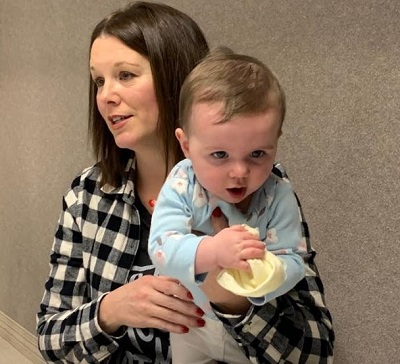Meet Stephanie Parsley: Heart Attack Survivor
7/29/2020
Her baby Brynne turns one as Stephanie celebrates her one-year survivor anniversary.
 A young woman who had always maintained a healthy weight, exercised and eaten a healthy diet - and with no family history of heart disease - Stephanie Parsley was shocked to experience two heart attacks within weeks of giving birth to her third child.
A young woman who had always maintained a healthy weight, exercised and eaten a healthy diet - and with no family history of heart disease - Stephanie Parsley was shocked to experience two heart attacks within weeks of giving birth to her third child.
After her daughter was born in August of 2019 and she went home from the hospital, Stephanie noticed some swelling in her feet but didn’t think much of it. It was when she laid down for a nap and noticed tightness in chest and shortness of breath that she became concerned. Her first thought was that it could be a pulmonary embolism, which can be common with women who’ve had babies. But she didn’t take any action at that time.
Several days later the pain continued. “One night, I woke up in the middle of night with bad chest pain that was radiating into my back and shoulder. I ‘googled’ it and it said I was having a heart attack. So I woke my husband up then called my OB Clinic* and the nurse-on-call told me it was probably just gas or muscular and not to worry about it unless it got worse. So I didn’t go to the hospital then. And, it didn’t get any worse, so I felt relieved.”
But two days later when Stephanie woke up with the same pain, her husband insisted on bringing her to the ER.** “My friends said that Northwest Medical Center-Springdale is ‘the heart hospital.’ And my aunt had heart bypass surgery there and said many good things about her experience.”
Stephanie’s EKG showed a 100% blockage in one vessel and a 99% blockage in two others. “It was really bad.”
When Interventional Cardiologist Dr. Michael Green saw her in the ER after reading the EKG, he was obviously shocked to see the young woman the EKG belonged to. “He said ‘YOU’RE the cardiac patient?” But this young mother was having a major heart attack, and went straight to the Cardiac Catheterization Lab where Dr. Green used 2 balloons and 1 stent to re-open her blocked vessels.
Stephanie was experiencing what’s known as a STEMI, an ST-elevated myocardial infarction. That’s a very serious type of heart attack during which at least one of the heart’s major arteries (a vessel that supplies oxygen to the heart muscle) is blocked. It is a life-threatening medical emergency, requiring immediate intervention. One of the quality measures for STEMI care is the “door-to-balloon” (D2B) time or the amount of time it takes to successfully re-open the occluded artery. The clock starts when the patient arrives at the hospital and stops when the blocked vessel is re-opened in the Cardiac Cath Lab, generally with a balloon or stent.
Stephanie’s door-to-balloon time was just 43 minutes, significantly better than the average state and national D2B times.
Dr. Green told her there was a little scar tissue on her heart, probably from the earlier heart attack when she initially delayed care. But Stephanie left the hospital happy to be alive and home with her family.
But then there was an additional complication. Stephanie’s body rejected the blood-thinning drug that helps to prevent platelets from sticking together and forming a blood clot that could re-block an artery. She had another heart attack just 22 days later. Fortunately she knew to come right back to the hospital. “Dr. Green had warned me that if the blockages recurred or another heart attack was happening, I would feel the same symptoms. So I knew exactly what to do and got to the hospital quickly. There was significantly less impact from this heart attack.
Stephanie and her husband Travis live between Rogers and Lowell with their 10 and 7 year-old sons, Brant and Briggs, and baby girl Brynne, who turns one year old on August. 5.
Her pediatrician has already referred her children to a pediatric cardiologist for baseline EKGs since Dr. Green told Stephanie she had narrow arteries and a genetic predisposition for heart disease.
She asked Dr. Green if she would forever be looking over her shoulder, expecting another heart attack. He told me to just ‘go live my life.’ So I’ve ridden roller coasters, played with my kids on the trampoline, resumed exercising, continued serving in my church and tried to enjoy every moment to the fullest.”
Additionally, this summer Stephanie shared her story as the “featured survivor” at the NWA American Heart Association’s Go Red for Women event, with a goal of helping other women.
“As women and mothers, we tend to push our health to the backburner and put everyone else ahead of ourselves. We might be afraid to inconvenience anyone, spend the money on an ER visit, or we may think we will be embarrassed if there is nothing wrong. It is imperative that women seek proper medical attention at the onset of symptoms. If it weren't for my husband's insistence to go to the hospital, I might not be alive today," she says.

*OB Clinic is not affiliated with Northwest Health.
**The American Heart Association recommends calling 9-1-1 for the best and most immediate care possible.
Back